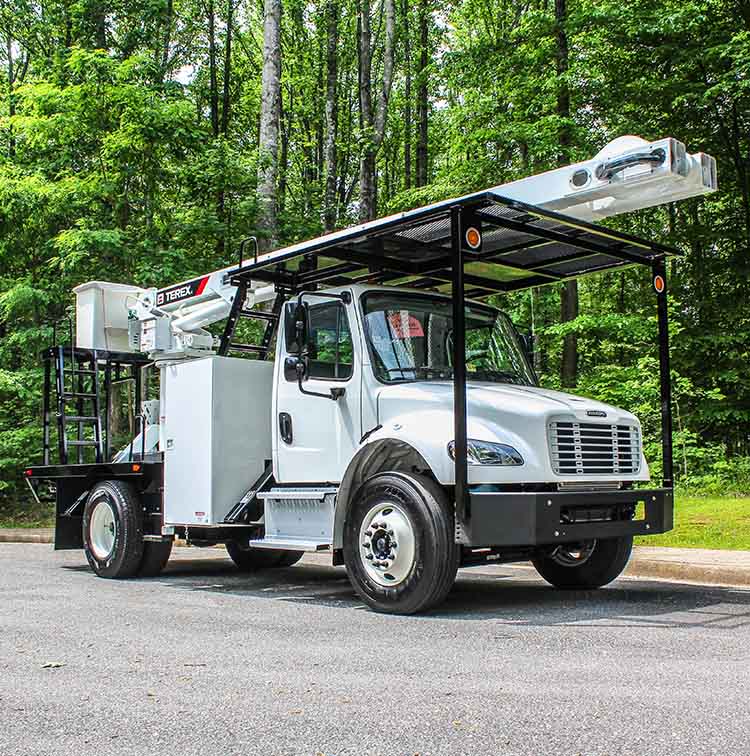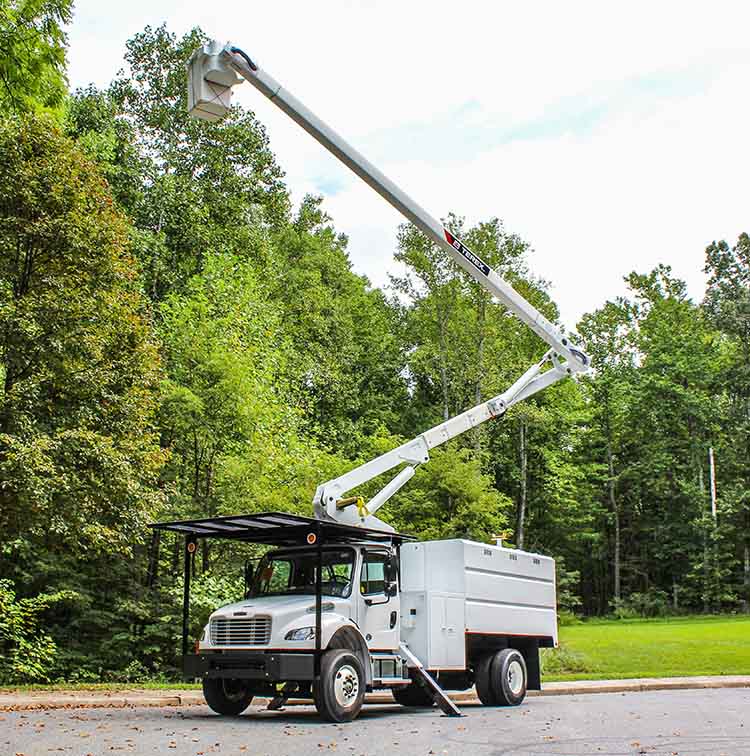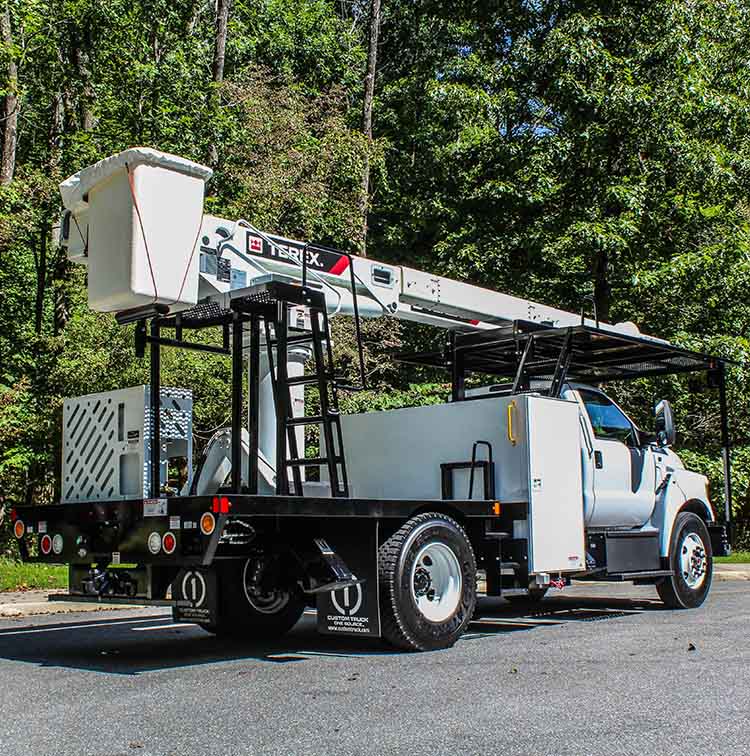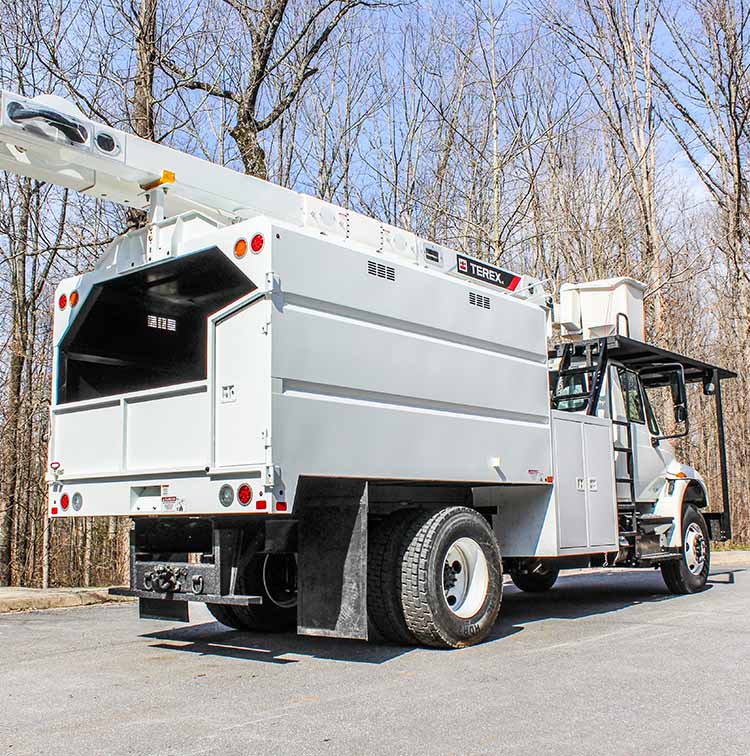

Trees and power lines are both incredibly important, yet the two can’t safely co-exist in close quarters. Trees conduct electricity and can create safety hazards if limbs grow too close to electric lines. Plus, there’s the threat of vegetation falling on power lines during heavy rains and storms, potentially leading to power outages and forest fires.
This is why the forestry industry comes in to prune and top trees that could compromise the safety of our power lines. They also cut down diseased, hazardous trees that could infect other healthy trees in the vicinity, as well as invasive insect-infested or dead ones that could aid in the spread of wildfires.
To do these tree trimming, tree maintenance, and tree removal jobs, the forestry industry uses specifically designed trucks that comes with a bucket, boom, and some with a chip box called forestry bucket trucks.
How do these help?
Forestry bucket trucks enable tree management crews to be safely lifted off the ground, while allowing the bucket to reposition and reach out-of-the-way spots that couldn’t be reached with a ladder — especially with power lines obstructing safe access to limbs and foliage.


Over the years, forestry bucket trucks have become indispensable for the customized advantages they offer the tree-trimming industry. The market for them today is booming.
According to a report by Global Market Insights, the global market valuation for forestry equipment will pass $17 billion by 2026. The rising demand for timber harvesting in residential applications will propel this market demand, as will the expansion of vegetation management efforts and conservation and reforestation drives.
“The densest forestry markets in the U.S. include the Northeast, East, Southeast, Upper Midwest, and Upper Northwest, so we see greater demand through our facilities in those regions,” said Fred Ross, CEO of Custom Truck One Source, a premier provider of forestry equipment in North America, during an interview with American Crane & Transport. “[The market] is definitely coming back and we couldn’t be more excited.”
Tree-trimming companies, independent “mom-and-pop” contractors, and production tree companies (which specialize in line clearance) form the largest portion of the forestry truck market. And with state governments in forest fire prone areas now tackling the seasonal hazard, demand for forestry trucks is slated to increase exponentially.
We spoke with John Dean, forestry equipment expert at Custom Truck One Source, to learn more about forestry trucks. He also answered some FAQs on forestry trucks that buyers are constantly searching the internet for.
Excerpts from the interview:
What are the types of trucks that are exclusively built for forestry?
There are two types. The first is called a `forestry bucket truck’, and it comes with a chip box on the back and an airlift mounted right behind the cab. The second is the `rear mount’ bucket truck, on which the airlift is mounted on the rear axle.
Why would someone buy a forestry bucket for their tree-trimming needs instead of a rear mount bucket?
For the ability to do more than one thing with the truck. A rear mount bucket is just going to do tree maintenance, which is pruning and removal only. With a forestry truck, you can do pruning, removal, and are able to chip and store the debris with the same truck.
How does the price compare between a forestry bucket truck and a rear mount?
The rear mount costs a little bit more because there are more labor-intensive materials involved in the build. For example, an extra set of outriggers that requires a little bit more hosing.
What is the most desirable piece of forestry equipment in the market today?
Everybody who’s in the forestry industry wants the XT Series by Terex, which is specifically designed for tree care.
You might find somebody using an old HRX or some other model, but they are usually up-and-coming operations that need a bucket truck but cannot afford a new or used XT.
What exactly is Terex’s new innovation – the Positive Attachment Lanyard (PAL)?
Terex has added yet another piece of safety equipment to reduce the hazards of tree-trimming, the Positive Attachment Lanyard. It is basically a warning system that reduces the chance of an operator elevating a bucket without a safety harness lanyard attached. If the worker doesn’t attach their lanyard to the anchor at the platform, audio and visual warnings will go off once controls engage.

Forestry trucks are more compact and the boom is smaller.
The `overcenter’ allows the operator to access hard-to-reach spots, provides greater flexibility, and adds several extra feet of side reach, which increases worker safety and ensures more efficient movement. They perform well in both open and congested areas, as the boom can be moved to several different working positions before the truck needs to relocate.
The upper boom will actually extend beyond the total vertical extension. So the articulation of the upper boom is above and beyond regular, utility-style booms. Also, they are dielectrically rated, which means if the boom comes in contact with a power line, it helps protect the personnel in the bucket. Of course, that does not mean you can touch the power line, but if for some reason there is accidental contact, it prevents the electricity from traveling to the bucket.
Perhaps that they are only designed to hold the operator and his tools in the bucket. Nothing else.

Terex’s XTs have been built for a very long time, and they have only changed the model twice over the years – which shows their top-notch engineering and design advantage. The first ones are now referred to as Terex XT Legacy and now we have the Terex XT Pro series.
The cost of overall maintenance for Terex forestry equipment is significantly cheaper. For example, our competitors' parts and services are a lot more expensive.
Unlike the round upper boom style used by other manufacturers, the Terex XT Pro Series has a rectangular boom, which helps to maintain its rigidness. Think of a fishing pole, with a round rod. The pole is meant to bend whenever a fish is caught. You don't want your boom acting in the same way while you're 60 feet in the air.
Some companies will offer what they refer to as a "maintenance-free boom". You buy them as is, and don’t do any maintenance. While that sounds great on paper, this no-maintenance feature actually becomes a problem in the long run. You actually want to do maintenance work like replacing grease when necessary. If something goes wrong, you have to call them in to take the boom, disassemble it, grease it, and put it back together. I think buyers would rather take a grease gun and do the job instead of dealing with all that needless expense.
The Terex XT Pro offers a much smoother operation, with a one-cylinder operated elbow linkage. It maintains one solid, fluid motion throughout the full articulation of the boom.
The Terex XT Pro 56, a forestry bucket truck that comes with your choice of chassis, including Freightliner, International, or any class 6 or 7 chassis. With a working height of 61’, an 11’ chip box, ample tool storage, and dual hydraulic tool connections at the platform, this truck, available under CDL, is perfect for line clearance, or for any company that needs the “do all” truck that can be driven by any licensed driver.
The second is the Terex XT Pro 60 Rear Mount bucket truck, which also comes with your choice of chassis. Available under CDL in 2wd, with a 65’ working height, optional 20,000 lb. front winch, dual hydraulic tool connections at the platform, custom 3-door toolbox, and the shortest wheelbase in the market, this truck is preferred by independent operators for its unmatched maneuverability, but they are just as widely used in line clearance applications.


A forestry bucket truck is the best choice for line clearance. For first-time buyers, a forestry truck with a chip box is always the best bet.
I typically recommend the rear mount to someone who already owns a chip truck. The theory is this: You send both the rear mount and the forestry bucket truck to a job. If you’re not done with the job, but your chip box is full, you need to fold up your aerial to go dump the chips. But when both units are on-site, the rear mount can be constantly working while the forestry truck is collecting chips. When the chip box is full, you take the truck and go dump it, but your aerial is still working on-site. So, with the combination of the two, the work doesn’t have to stop.
On small-scale jobs though, the forestry bucket truck with the chip box is sufficient. It’s all about scale, planning, and scheduling.
The Terex XT series comes with two hydraulic fittings, so I always recommend that you buy hydraulic tools for the forestry or the rear-mount bucket truck. Other than that, the Terex trucks are well kitted-out for most basic needs. The toolbox base is really nice. Compared to our competitors, the toolbox on the rear-mounts is a through box, so you can open one door and see right through to the other side. Some manufacturers put their hydraulic tank in the middle of the deck in the toolbox, so you lose the ability to put longer tools in there.